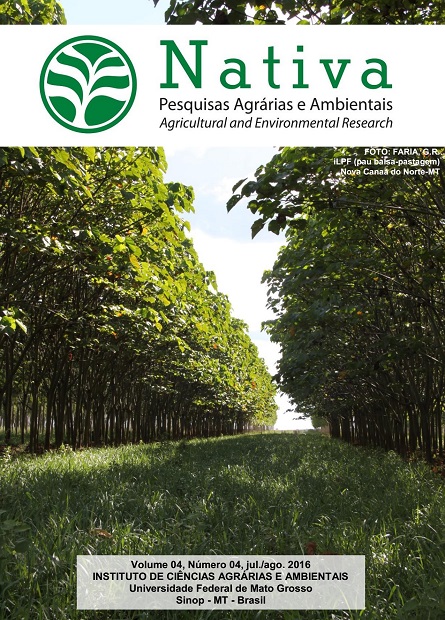DIFERENTES CONCENTRAÇÕES DE RETARDANTE DE FOGO EM PLANTIOS DE EUCALIPTO
DOI:
https://doi.org/10.31413/nativa.v4i4.2860Resumo
Incêndio florestal é um dos maiores causadores de prejuízos no triângulo da sustentabilidade no meio florestal, ou seja, ele proporciona prejuízos econômicos, ambientais e sociais. Esta pesquisa teve o objetivo de avaliar o efeito de diferentes concentrações de retardante de fogo sob a intensidade de queima e altura de chamas em plantio de eucalipto. O experimento foi conduzido com 3 distintas concentrações de retardante de fogo (1,5, 2,0 e 3,0%) além de testemunha com água. A dosagem de calda da mistura do retardante com água utilizada nesta pesquisa foi de 0,5 L m-2 de área. Durante a queima de cada unidade amostral foram avaliadas as seguintes variáveis: umidade relativa, velocidade do vento, tempo gasto para o fogo queimar a parcela com e sem o produto, altura das chamas e a distância que o fogo avançou na parcela. Para a análise foi calculado a intensidade de queima da unidade amostral por concentração do produto. O efeito das concentrações do retardante foi evidenciado, visto que apresentou diferenças significativas pelo teste Tukey em nível de 95% de probabilidade, diferenciando-se da testemunha (água). A concentração mais eficiente foi a de 3,0% com menores taxas de intensidade de queima e altura de chamas.
Palavras-chave: incêndios florestais, proteção florestal, intensidade de queima.
DIFERENT CONCENTRATIONS OF FIRE RETARDANT IN EUCALYPTUS PLANTATIONS
ABSTRACT
This research aimed to evaluate the effect of different concentrations of fire retardant under the
intensity and height of flames burning in Eucalyptus plantations. The experiment was conducted in a rural property
in the south of the Espírito Santo, Brazil, conducted with three concentrations (1.5, 2.0 and 3.0%) in addition to
treatment with water. The dosage of tail mixture of the with water retardant used in this study was 0.5 L m-2 of
area. During the firing of each plot (treatment/repeat) the following variables were evaluated: relative wind speed,
humidity time spent by the fire burn the plot with and without the product, height of the flames and the distance
advanced by the fire in the plot. For analysis of the intensity of the burning portion was calculated by concentration
of product. The effect of concentrations of retardant was evident, since they showed significant difference by Tukey
test at 5% probability, differentiating itself from the control (water). The most effective concentration was 3.0% for
both situations, intensity and height of flames burning, with the lowest rates of lower flammability and flame heights.
Keywords: forest fire, forest protection, burning intensity.
Referências
BATISTA, A. C. et al. Avaliação da eficiência de um retardante de longa duração, à base de polifosfatoamônico, em queimas controladas em condições de laboratório. Scientia Forestalis, Piracicaba, v.36, n.79, p.223-229, 2008
BYRAM, G. M. Combustion of forest fuels. In: DAVIS, K. P. Forest fire - control and use. New York: McGraw Hill, 1959. p.77-84.
FIEDLER, N. C.; CANZIAN, W. P.; MAFIA, R. G.; RIBEIRO, G. A.; KRAUSE JUNIOR, J. Intensidade de queima de diferentes retardantes de fogo. Revista Árvore, Viçosa, v.39, n.4, p.691-696, 2015.
ICNF - Instituto da Conservação da Natureza e das Florestas. Relatório provisório de Incêndios Florestais 2015. Disponível em: < http://www.icnf.pt/portal/florestas/dfci/Resource/doc/rel/2015/1-relprov-1jan-15jun-2015>. Acessado em 22 Jan. 2016.
INCAPER - Instituto Capixaba de Pesquisa, Assistência Técnica e Extensão Rural. Programa de Assistência Técnica e Extensão Rural 2010. Disponível em: < http://www.incaper.es.gov.br/proater/municipios/Caparao/Alegre.pdf>. Acessado em 18 Jun. 2014.
MACHADO FILHO, C.; MARTINS, M. C.; RIBEIRO, G. A.; LIMA, G. S.; CARDOSO, M. T.; TORRES, C. M. M. E.; PINTO, F. B. Eficiência de um retardante de fogo de longa duração utilizado em incêndios florestais. Ciência Florestal, Santa Maria, v.22, n.2, p.365-371, 2012.
PARIZOTTO, W.; SOARES, R. V.; BATISTA, A. C.; SOUSA, N. J. Controle dos incêndios florestais pelo corpo de bombeiros de
Santa Catarina: Diagnóstico e sugestões para seu aprimoramento. Floresta, Curitiba, v.38, n.4, p.651-662, 2008. http://dx.doi.org/10.5380/rf.v38i4.13160
RIBEIRO, G. A.; LIMA, G. S.; OLIVEIRA, A. L. S. de; CAMARGOS, V. L. de; MAGALHÃES, M. U. Eficiência de um retardante de longa duração na redução da propagação do fogo. Revista Árvore, Viçosa, v.30, n.6, p.1025-1031, 2006.
SANT’ANNA, C. M.; FIEDLER, N. C.; MINETTE, L. J. Controle de incêndios florestais. Alegre: Suprema, 2007. 152p.
SANTOS, J. F.; SOARES, R. V.; BATISTA, A. C. Perfil dos incêndios florestais no Brasil em áreas protegidas no período de 1998 a
Floresta, Curitiba, v.36, n.1, p.93-100, 2006. http://dx.doi.org/10.5380/rf.v36i1.5510
SOARES, R. V.; SANTOS, J. F. Perfil dos incêndios florestais no Brasil de 1994 a 1997. Floresta, Curitiba, v.32, n.2, p.219-225, 2002. http://dx.doi.org/10.5380/rf.v32i2.2287
SOUZA, H. N.; ARAÚJO, T. G. de; RIBEIRO, G. A. Avaliação da eficiência de um gel hidroretentor como retardante de fogo. Revista Árvore, Viçosa, v.36, n.3, p.471-477, 2012.
Downloads
Publicado
Edição
Seção
Como Citar
Licença
Direitos Autorais para artigos publicados nesta revista são do autor, com direitos de primeira publicação para a revista. Em virtude de a aparecerem nesta revista de acesso público, os artigos são de uso gratuito, com atribuições próprias, em aplicações educacionais e não-comerciais.
A artigos publicados nessa revista, podem ser reproduzidos parcialmente ou utilizados como referência por outros autores, desde que seja cita a fonte, ou seja, a Revista Nativa.
Copyright for articles published in this journal are the authors, with first publication rights granted to the journal. The journal shows open access, and articles are free to use, with proper attribution, in educational and non-commercial.
The articles published in this journal may be reproduced in part or used as a reference by other authors, provided that the source is quoted.






